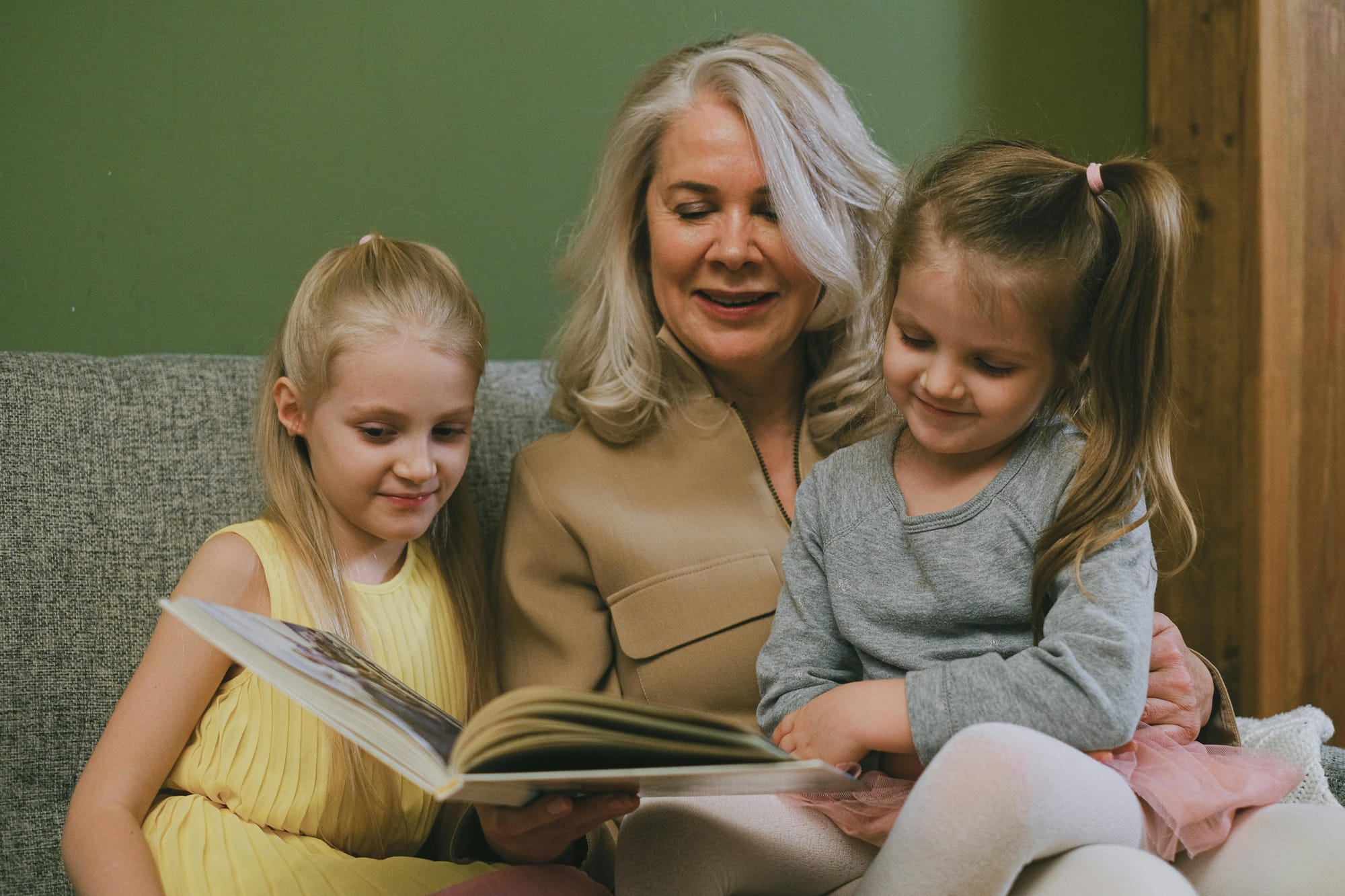Read, read, read!

Among the all-time great things to do with children, reading is right at the top! It’s great for the kids because it helps prepare them for reading on their own, and it “strengthens children’s social, emotional, and character development,” in part by teaching them words for their feelings.
Reading with the grandchildren is also great for grandparents, because:
• You get to engage the child’s curiosity
• You get to help them toward being a reader
• You get to cuddle with them
• It opens conversations
• A good children’s book will entertain and educate you, too
And!
• It can be done long-distance
• It’s inexpensive or free
• You can do it if you’re not physically fit

Getting started
If you want to start reading with your grandchild, but your reading-to-kids skills are rusty, a few pointers can help you get started:
Find a comfortable place to read, and make that place your reading zone. Remember that your grandparental-eyes probably need good light even for picture books!
Choose a good book. Try reading a classic favorite appropriate to the child’s age. Here is a great list from the New York Public Library. https://www.nypl.org/books-more/recommendations/125/kids Some favorites for our kids and grandkids included on the list are Goodnight Moon, Blueberries for Sal, The Carrot Seed, Pat the Bunny, The Snowy Day, and The Story of Ferdinand. (The grandkids would want me to include Captain Underpants and Everyone Poops on the short list!)
Alternatively, find out from the parents what books the child especially likes, and which they have outgrown.
Once you gauge what interests your grandchild, go with that (allowing for a little branching out here and there). For example, one of our preschool grandchildren loved Scaredy Squirrel books. We’d return to these again and again, adding in new titles as they were available at our library.
In addition to choosing the kinds of storybooks they like, pay attention to what else interests them, and get age-appropriate or somewhat age-stretching books about that topic. When the book is age-stretching—meaning there are too many words, or the explanations are too complex—let the child absorb the illustrations, and paraphrase the text, or just read the parts that catch their attention. We have done this with books on motors, astronomy, ocean life, dinosaurs…it’s amazing what they learn and recall months later.
Remember that young children actually like to read books over and over.
Also, that they don’t necessarily want to read the author’s words—sometimes talking about what interests them in the pictures engages them more. For example, my sister “reads” Richard Scarry vehicle books to her 3-year-old grandson by selecting a character, such as Lowly Worm, and following the character through the book.

Overcoming obstacles to reading
While I obviously can’t anticipate all the obstacles to reading, a few are so common that I’ll offer some ideas here:
Babies and toddlers often tear pages or chew on books, which can become a distraction or disincentive to reading to them. To minimize the issues, stick with reading board books as much as possible. (Also, no screens except video chats, per the American Academy of Pediatrics.)
Speaking of video chats, long-distance reading can be a great way to connect with a grandchild. One way to arrange this is to purchase two copies of a book and send one to your grandchild, so that you each have the same physical book to hold while you chat online. This approach could obviously get expensive. Or, per a suggestion from children’s literature specialist Sylvie Shaffer, you could prop your phone in a small tripod, which will allow you to position the phone and book to show the pictures to your grandchild via FaceTime or similar. This way, you could either purchase one copy to read, or check out library books. For the least expensive route, Shaffer suggests that both of you (you and the child’s parents) could borrow the same book via Libby. Then the child could follow along on a tablet or other device while you read together. (My tips for Libby: It’s pretty intuitive to use, but it took me a bit to figure out how to turn the pages. Try it before your first reading session! Also, you and the parents need to plan ahead: E-books aren’t necessarily available when you want them.)
Don’t push it. All kinds of things can derail a reading session—hunger, needing physical play, and distraction are super-common and typically need to be taken care of before the child can settle down to read.
Too much or too little physical closeness can also detract from the experience: For some grandchild/grandparent combinations, reading teacher-style with the child on the floor, showing them the pictures, will be more comfortable for one or both than cuddling in the same chair. For other pairs, the cuddle will help the child’s body calm enough to listen. Gauge what works for you and your grandchild.
Inadequate acquaintance or disrupting a pattern are other possible obstacles: When one of our grandchildren was about two, he didn’t want us to read to him. Partly, he didn’t know us well yet—we were at that time infrequent voices/faces on a screen—and partly, reading was what he did with Mama and Daddy bedtime, not what he did with other people.
Make it fun
All this helps, I think, with the overall goal of reading to children—which is that it be a pleasure for them, so that the habit of reading can become a lifelong source of joy and education. Grandparents can help a lot with this goal, and enjoy themselves and their relationship with their grandchild at the same time—happy reading!